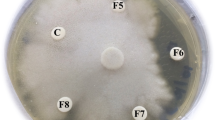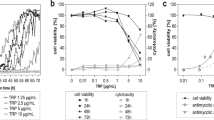Abstract
Prodigiosins (PGs) are known to be a family of natural red pigments, characterized by a common pyrrolydipyrrolylmethane skeleton structure with a C-4 methoxy group, and some of these pigments have been isolated from some microorganisms. Members of the PG family have been reported to show several biological activities, such as immunosuppressive and cytotoxic activities. Recently, we discovered a bacterial strain (MS-02-063), from our microbial library, that produces large amounts of a PG analogue (PG-L-1). In this study, we examined the anti-Trichophyton activity of PG-L-1 (produced by strain MS-02-063) against clinically isolated Trichophyton spp., by a method using stratum corneum epidermis (SCE) of the Yucatan micropig, which is suitable for estimating the antifungal activity of drugs in vitro. In the National Committee for Clinical Laboratory Standards (NCCLS) method, PG-L-1 showed potent antifungal activity against nine clinically isolated strains of Trichophyton spp., although the minimum inhibitory concentration (MIC) values were slightly higher than those of bifonazole. In spite of the lower efficiency of PG-L-1 transfer into SCE from medium than that of bifonazole, PG-L-1 transferred into SCE showed more potent antifungal activity than bifonazole, at lower concentrations.
Similar content being viewed by others
References
DJ Sheehan CA Hitchcock CM Sibley (1999) ArticleTitleCurrent and emerging azole antifungal agents Clin Microbiol Rev 12 40–79 Occurrence Handle1:CAS:528:DyaK1MXpvVOlsw%3D%3D Occurrence Handle9880474
R Schopf O Hettler M Brautigam G Weidinger U Kaben P Mayser et al. (1999) ArticleTitleEfficacy and tolerability of terbinafine 1% topical solution used for 1 week compared with 4 weeks clotrimazole 1% topical solution in the treatment of interdigital tinea pedis: a randomized, double-blind, multi-centre, 8-week clinical trial Mycoses 42 415–20 Occurrence Handle10.1046/j.1439-0507.1999.00477.x Occurrence Handle1:CAS:528:DyaK1MXmslGgt78%3D Occurrence Handle10536434
A Espinel-Ingroff (2001) ArticleTitleComparison of the E-test with the NCCLS M38-P method for antifungal susceptibility testing of common and emerging pathogenic filamentous fungi J Clin Microbiol 39 1360–7 Occurrence Handle10.1128/JCM.39.4.1360-1367.2001 Occurrence Handle1:CAS:528:DC%2BD3MXjtlSlt7g%3D Occurrence Handle11283057
A Espinel-Ingroff K Dawson M Pfaller E Anaissie B Breslin D Dixon et al. (1995) ArticleTitleComparative and collaborative evaluation of standardization of antifungal susceptibility testing for filamentous fungi Antimicrob Agents Chemother 39 314–9 Occurrence Handle1:CAS:528:DyaK2MXjsFCisbo%3D Occurrence Handle7726488
C Llop I Pujol C Aguilar J Sala D Riba J Guarro (2000) ArticleTitleComparison of three methods of determining MIC for filamentous fungi using different end point criteria and incubation periods Antimicrob Agents Chemother 44 239–42 Occurrence Handle10.1128/AAC.44.2.239-242.2000 Occurrence Handle1:CAS:528:DC%2BD3cXmvFGitA%3D%3D Occurrence Handle10639343
I Pujol J Guarro C Llop L Soler J Fernandez-Ballart (1996) ArticleTitleComparison study of broth macrodilution and microdilution antifungal susceptibility tests for the filamentous fungi Antimicrob Agents Chemother 40 2106–10 Occurrence Handle1:CAS:528:DyaK28XlsVChtrg%3D Occurrence Handle8878589
T Ariga T Hase M Yokoo (1990) ArticleTitleActivity of topical antifungals on infected sites – skin permeability and adsorption to horny materials Nishinihon J Dermatol 52 545–9
CN Okeke R Tsuboi M Kawai H Ogawa (2000) ArticleTitleFluorometric assessment of in vitro antidermatophytic activities of antimycotics based on their keratin-penetrating power J Clin Microbiol 38 489–91 Occurrence Handle1:CAS:528:DC%2BD3cXht1aqtLg%3D Occurrence Handle10655333
Y Niwano N Kuzuhara H Kodama M Yoshida T Miyazaki H Yamaguchi (1998) ArticleTitleIn vitro and in vivo antidermatophyte activities of NND-502, a novel optically active imidazole antimycotic agent Antimicrob Agents Chemother 42 967–70 Occurrence Handle1:CAS:528:DyaK1cXisFGmtLk%3D Occurrence Handle9559824
K Uchida H Yamaguchi (1991) ArticleTitleRetention of amorolfine in the skin tissue as measured by prevention of the development of experimental dermatophytosis in guinea pigs Jpn J Antibiot 44 1032–41 Occurrence Handle1:CAS:528:DyaK3MXmslSjtL0%3D Occurrence Handle1960853
K Uchida H Yamaguchi (1994) ArticleTitleProphylactic effect of oral terbinafine on the development of infection in guinea pigs inoculated with Trichophyton mentagrophytes Jpn J Antibiot 47 50–6 Occurrence Handle1:CAS:528:DyaK2cXitVyjsr8%3D Occurrence Handle8114273
H Wakabayashi K Uchida K Yamauchi S Teraguchi H Hayasawa H Yamaguchi (2000) ArticleTitleLactoferrin given in food facilitates dermatophytosis cure in guinea pig models J Antimicrob Chemother 46 595–602 Occurrence Handle10.1093/jac/46.4.595 Occurrence Handle1:CAS:528:DC%2BD3cXnsl2kurs%3D Occurrence Handle11020258
K Uchida H Yamaguchi (1996) ArticleTitlePreclinical therapeutic evaluation of agents for treating dermatophytosis Jpn J Med Mycol 37 199–205 Occurrence Handle1:CAS:528:DyaK2sXksFCntA%3D%3D
T Nakashima A Nozawa TA Majima (2002) ArticleTitlenovel method using micropig stratum corneum in vitro for the evaluation of anti-Trichophyton mentagrophytes activity Microbiol Immunol 46 521–5 Occurrence Handle1:CAS:528:DC%2BD38XntlCktbY%3D Occurrence Handle12363015
Nakashima T, Kato Y, Takeshita S, Matsuda N, Kodama Y, Watanabe M. Japanese patent (Jpn Syutugan Tokkyo Megai), 2004;2004-078807
MJ Gauthier VA Breittmayer (1992) The genera Alteromonas and Marinomonas A Balows HG Truper M Dworkin W Harder KH Schleifer (Eds) The prokaryotes Springer-Verlag New York Berlin Heidelberg Tokyo
EG Allen (1967) ArticleTitleConditions of the colour change of prodigiosin Nature 216 929–31 Occurrence Handle1:CAS:528:DyaF1cXjs1Shsw%3D%3D Occurrence Handle6074975
NN Gerber DP Stahly (1975) ArticleTitleProdiginine (prodigiosin-like) pigments from Streptoverticillium rubrireticuli, an organism that causes pink staining of polyvinyl chloride Appl Microbiol 30 807–10 Occurrence Handle1:CAS:528:DyaE28XhsVCluw%3D%3D Occurrence Handle1200630
National Committee for Clinical Laboratory Standards. Reference method for broth dilution antifungal susceptibility testing of conidium forming filamentous fungi. Proposed standard M38-A. Wayne, PA: National Committee for Clinical Laboratory Standards; 2002
V Kassis J Sondergaard (1982) ArticleTitleHeat-separation of normal human skin for epidermal and dermal prostaglandin analysis Arch Dermatol Res 273 301–6 Occurrence Handle10.1007/BF00409259 Occurrence Handle1:CAS:528:DyaL38Xlt1Slsb8%3D Occurrence Handle6762159
U Tauber (1988) ArticleTitlePharmacokinetics of antimycotics with emphasis on local treatment Ann N Y Acad Sci 544 414–26 Occurrence Handle1:STN:280:BiaC3cvitVE%3D Occurrence Handle3063179
K Uchida H Yamaguchi (1993) ArticleTitleStudies on the affinity of terbinafine with keratin Jpn J Med Mycol 34 207–12 Occurrence Handle1:CAS:528:DyaK3sXlsFWmtLc%3D
T Arika T Hase M Yokoo (1993) ArticleTitleAnti-Trichophyton mentagrophytes activity and percutaneous permeation of butenafine in guinea pigs Antimicrob Agents Chemother 37 363–5 Occurrence Handle1:CAS:528:DyaK3sXhtl2gs7Y%3D Occurrence Handle8452371
Y Niwano M Matsui T Tabuchi K Kanai H Hamaguchi T Miyazaki et al. (1997) ArticleTitleStudies on the antifungal activity of the new imidazole antimycotic lanoconazole in infected sites. Arzheimittelforschung/ Drug Res 47 1056–60 Occurrence Handle1:CAS:528:DyaK2sXmt12hu7c%3D
F Alois (2003) ArticleTitleChemistry and biology of roseophilin and the prodigiosin alkaloids: a survey of the last 2500 years Angew Chem Int Ed 42 3582–603 Occurrence Handle10.1002/anie.200300582
M Isaka A Jaturapat J Kramyu M Tanticharoen Y Thebtaranonth (2002) ArticleTitlePotent in vitro antimalarial activity of metacycloprodigiosin isolated from Streptomyces spectabilis BCC 4785 Antimicrob Agents Chemother 46 1112–3 Occurrence Handle10.1128/AAC.46.4.1112-1113.2002 Occurrence Handle1:CAS:528:DC%2BD38XisVSjtbw%3D Occurrence Handle11897600
M Patricia N Duran M Haun (2000) ArticleTitleCytotoxicity of prodigiosin and benznidazole on V79 cells Toxicol Lett 116 237–42 Occurrence Handle10.1016/S0378-4274(00)00226-5 Occurrence Handle10996486
R Pandey R Chander BA Sainis (2003) ArticleTitlenovel prodigiosin-like immunosuppressant from an alkalophilic Micrococcus sp Int Immunopharmacol 3 159–67 Occurrence Handle10.1016/S1567-5769(02)00114-5 Occurrence Handle1:CAS:528:DC%2BD3sXhtVemt7c%3D Occurrence Handle12586597
N Gerber (1975) ArticleTitleProdigiosin-like pigments CRC Crit Rev Microbiol 3 469–85 Occurrence Handle1:CAS:528:DyaE2MXkslGisbk%3D Occurrence Handle1095305
R Perez-Tomas B Montaner E Llagostera V Soto-Cerrato (2003) ArticleTitleThe prodigiosins, proapoptotic drugs with anticancer properties Biochem Pharmacol 66 1447–52 Occurrence Handle10.1016/S0006-2952(03)00496-9 Occurrence Handle1:CAS:528:DC%2BD3sXnvVeqsr0%3D Occurrence Handle14555220
H Vanden Bossche J Ausma H Bohets K Vermuyten G Willemsens P Marichal et al. (2004) ArticleTitleThe novel azole R126638 is a selective inhibitor of ergosterol synthesis in Candida albicans, Trichophyton spp., and Microsporum canis Antimicrob Agents Chemother 48 3272–8 Occurrence Handle10.1128/AAC.48.9.3272-3278.2004 Occurrence Handle15328084
Author information
Authors and Affiliations
Corresponding author
About this article
Cite this article
Nakashima, T., Kato, Y., Yamaguchi, K. et al. Evaluation of the anti-Trichophyton activity of a prodigiosin analogue produced by γ-proteobacterium, using stratum corneum epidermis of the Yucatan micropig. J Infect Chemother 11, 123–128 (2005). https://doi.org/10.1007/s10156-005-0376-0
Received:
Accepted:
Issue Date:
DOI: https://doi.org/10.1007/s10156-005-0376-0




